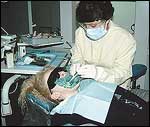|
|
Highlights of this issue

Chemoprevention of breast cancer
 Tamoxifen is well established as adjuvant therapy for early breast cancer and has been shown to reduce the risk of contralateral breast cancer. Raloxifene, currently used to prevent and treat osteoporosis, has been shown in animal models to prevent the growth of new mammary cancers. In the latest of CMAJ's series of clinical practice guidelines for the diagnosis and management of breast cancer, the Canadian Task Force on Preventive Health Care and the Steering Committee on Clinical Practice Guidelines for the Care and Treatment of Breast Cancer examine the evidence surrounding the use of these agents for the prevention of breast cancer in women at normal, low and high risk. They also provide guidelines to assist physicians in counselling their patients about the potential benefits and harms of chemoprevention.
Tamoxifen is well established as adjuvant therapy for early breast cancer and has been shown to reduce the risk of contralateral breast cancer. Raloxifene, currently used to prevent and treat osteoporosis, has been shown in animal models to prevent the growth of new mammary cancers. In the latest of CMAJ's series of clinical practice guidelines for the diagnosis and management of breast cancer, the Canadian Task Force on Preventive Health Care and the Steering Committee on Clinical Practice Guidelines for the Care and Treatment of Breast Cancer examine the evidence surrounding the use of these agents for the prevention of breast cancer in women at normal, low and high risk. They also provide guidelines to assist physicians in counselling their patients about the potential benefits and harms of chemoprevention.
Developmental dysplasia of the hip
 For most infants, developmental dysplasia of the hip (DDH) resolves spontaneously in the first months of life. For a minority, persistent DDH may result in chronic pain, gait abnormalities and degenerative arthritis. The Canadian Task Force on Preventive Health Care updates its 1994 recommendations for the detection and management of this condition. The task force considers serial clinical examination, ultrasound screening and radiographic evaluation as diagnostic methods, and operative intervention and abduction therapy as treatment strategies. The effect of delayed diagnosis and false diagnostic labelling are also examined, and long-term functional outcomes considered.
For most infants, developmental dysplasia of the hip (DDH) resolves spontaneously in the first months of life. For a minority, persistent DDH may result in chronic pain, gait abnormalities and degenerative arthritis. The Canadian Task Force on Preventive Health Care updates its 1994 recommendations for the detection and management of this condition. The task force considers serial clinical examination, ultrasound screening and radiographic evaluation as diagnostic methods, and operative intervention and abduction therapy as treatment strategies. The effect of delayed diagnosis and false diagnostic labelling are also examined, and long-term functional outcomes considered.
Surviving in the report card era
According to Jack Tu and his colleagues, "report cards" are here to stay. Many provinces are developing measures for various aspects of system, hospital and even individual performance. Given the interest shown by policy-makers, the media and the public, the results are likely to be widely distributed. The authors suggest ways for physicians to survive the report card era, including ensuring that good-quality data are collected by unbiased observers, monitoring and seeking to improve their own practice, ensuring that the process as well as outcomes are reported, and becoming involved by lending their clinical insight or statistical acumen to the development of appropriate report cards.
Equity in society and health care
Equity is the common theme of 2 commentaries in this issue. Stephen Bezruchka examines the effect of social hierarchy as measured by income distribution, which appears to outweigh the effect of individual behaviours. Canada's population health, as measured by life expectancy, is among the highest in the world, but the social contract that sustains this standing may be threatened by pressures to globalize our economy. Meanwhile, Jack Geiger considers the evidence for inequities in health care in different racial and ethnic groups. Studies from the United States provide direct evidence that patients from ethnic minorities are less likely to receive clinical attention. Although Geiger takes hope in current interest in training physicians for cultural competence, he cautions that a change in outcomes rather than attitudes is the true indicator of success.
HIV infection, dentists and patients
 The balance between patient protection and health care workers' rights is one theme that emerges from Michael Gardam and coauthors' review of the evidence for risk of HIV transmission from health care workers, particularly dentists, to patients. Two studies have shown probable transmission during dental or surgical procedures, leading to the conclusion that the risk of transmission is small, but not negligible. Guidelines reject mandatory testing but have variable recommendations on voluntary testing, expert review of risks and practice restrictions for health care workers with known HIV infection. Workers at risk are considered ethically obligated to know their HIV status, and professional associations and regulatory bodies require reporting and review; however, these protocols remain potentially subject to legal challenge.
The balance between patient protection and health care workers' rights is one theme that emerges from Michael Gardam and coauthors' review of the evidence for risk of HIV transmission from health care workers, particularly dentists, to patients. Two studies have shown probable transmission during dental or surgical procedures, leading to the conclusion that the risk of transmission is small, but not negligible. Guidelines reject mandatory testing but have variable recommendations on voluntary testing, expert review of risks and practice restrictions for health care workers with known HIV infection. Workers at risk are considered ethically obligated to know their HIV status, and professional associations and regulatory bodies require reporting and review; however, these protocols remain potentially subject to legal challenge.
Copyright 2001 Canadian Medical Association or its licensors |

